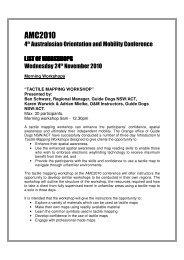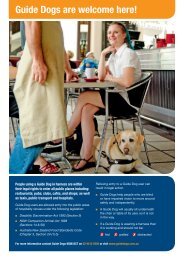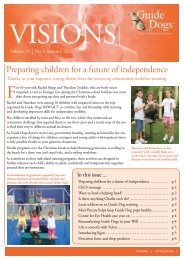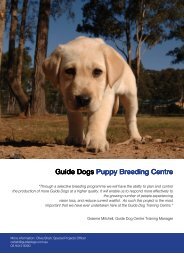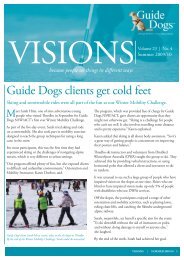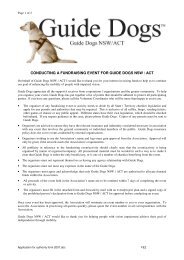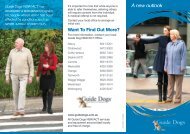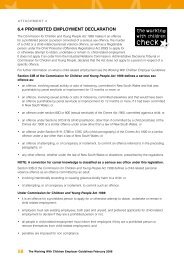AMC2010 - Guide Dogs NSW/ACT
AMC2010 - Guide Dogs NSW/ACT
AMC2010 - Guide Dogs NSW/ACT
You also want an ePaper? Increase the reach of your titles
YUMPU automatically turns print PDFs into web optimized ePapers that Google loves.
The CMS team answered this question by deciding<br />
to challenge students to plan and run their own<br />
mobility program in the busiest capital city in<br />
Australia - Sydney.<br />
2. Title: The Miniguide: Ten Years Down<br />
the Track<br />
Author: Jeremy Hill, Regional Manager, <strong>Guide</strong><br />
<strong>Dogs</strong> <strong>NSW</strong>/<strong>ACT</strong><br />
Summary: The development of the electronic travel<br />
aid, The Miniguide is firmly rooted in meeting the<br />
needs of the consumer. In 2000, <strong>Guide</strong> <strong>Dogs</strong> <strong>NSW</strong>/<br />
<strong>ACT</strong> was approached by the inventor who was<br />
seeking to trial the Miniguide with potential users.<br />
The prototype was refined over an intensive testing<br />
period to take into account customer feedback.<br />
Over the past ten years, over seven hundred and<br />
fifty clients in <strong>NSW</strong> and <strong>ACT</strong> have been trained and<br />
issued with Miniguides.<br />
A survey was recently carried out of one hundred<br />
randomly selected clients of various ages,<br />
environments and travel needs who presently use<br />
or have used a Miniguide. The results reflect the<br />
adaptability of the aid, the ingenuity of the users<br />
and the imagination of the instructors.<br />
3. Title: Review of Current Practices in<br />
Teaching Spatial Concepts and Navigation and<br />
Advantages in Using GPS Devices to Improve<br />
the Practical Spatial Knowledge of People who<br />
have Significant Vision Impairment<br />
Authors: Ewa Borkowski, Regional Manager, and<br />
Des Creagh, Project Officer, <strong>Guide</strong> <strong>Dogs</strong> <strong>NSW</strong>/<strong>ACT</strong><br />
Summary: O&M is about navigation, and knowing<br />
where you are in space, is the major component of<br />
navigation. Significant vision impairment affects the<br />
way a person perceives the environment.<br />
Teaching navigation, which is an important skill for<br />
independent and safe mobility, is the most critical<br />
skill taught by an O&M Instructor. This paper<br />
evaluates how we teach spatial concepts and<br />
navigation skills in current O&M practice in <strong>NSW</strong>/<br />
<strong>ACT</strong>. It examines the benefits of using GPS devices<br />
to teach a person with significant vision impairment<br />
the concepts of spatial awareness and navigation.<br />
2:00pm Session 5, Forum A: Program<br />
evaluation. Room: Menzies Common Room<br />
1. Title: Unilateral Spatial Neglect: Top Down<br />
Approach, Bottom Up Approach or Both?<br />
A Research Project Investigating Prismatic<br />
Adaptation, Visual Scanning Training and<br />
Transference into the Real World<br />
Author: Tracey Stuart, O&M Instructor, Acquired<br />
Brain Injury Vision Service, <strong>Guide</strong> <strong>Dogs</strong> SA.NT<br />
Summary: Visual neglect (or inattention),<br />
following right hemisphere injury, has long been<br />
acknowledged as an influencing factor on a<br />
person’s ability to operate at an expected and<br />
consistent level.<br />
For approximately 30 years, <strong>Guide</strong> Dog<br />
Associations have implemented a “top down”<br />
visual scanning program developed from the<br />
compensatory strategies of Diller and co-workers.<br />
A “bottom up” approach is prismatic<br />
adaptation, where a Fresnel prism is used to<br />
marginally shift the visual field to the right and a<br />
brief exercise undertaken.<br />
<strong>Guide</strong> <strong>Dogs</strong> SA.NT are embarking on a research<br />
project which combines the traditional “top down”<br />
approach with the “bottom up” approach of prism<br />
adaptation and then transfer and reinforce the skills<br />
in a range of dynamic, every day environments.<br />
2. Title: Scanning Training for Acquired Brain<br />
Injury: Where is the Research?<br />
Author: Allison Hayes, NVT Systems<br />
Summary: After 25 years how can it be<br />
possible that so little research data is available<br />
to support the efficacy of compensatory visual<br />
scanning training?<br />
This presentation will look at the reasons why<br />
this research has been so long in coming. The<br />
discussion will include the development and use of<br />
a validated outcome measure that relates to vision<br />
skills for mobility. The presentation will also outline<br />
the development of a standardized protocol for<br />
the assessment of all aspects of vision affected by<br />
acquired brain injury.<br />
Finally, the results of a collaborative clinical study<br />
conducted over two years in South Australia will<br />
be reviewed.<br />
3. Title: TBI Vision Therapy for Veterans of the<br />
Iraq and Afghanistan Conflicts<br />
Authors: Gayle Clarke and Allison Hayes,<br />
NVT Systems<br />
Summary: The major injury sustained by veterans<br />
of the Iraq and Afghanistan conflicts is Traumatic<br />
Brain Injury (TBI). Over 33% of all wounded were<br />
diagnosed with mild, moderate or severe TBI,<br />
although these figures are thought to be highly<br />
underestimated. 13% of all evacuated wounded<br />
have sustained direct eye trauma.<br />
Concerning studies are revealing that 75% of<br />
those with TBI injuries have visual complaints.<br />
Approximately 60% of those injured have<br />
associated neurological visual disorders as well<br />
as diplopia, convergence disorder, photophobia,<br />
ocular-motor dysfunction, and an inability to<br />
interpret print.<br />
28



